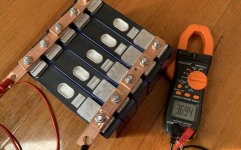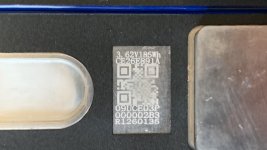It's not false, it's basic electronics. How about you provide some kind of reasoning or proof before you go around mistakenly telling people that they are wrong?
[/quote]
You are not dropping half a volt on 20 gauge wire with 2.5A through it at 3.6 volts. .. That is the first clue. . This is the basis for why , what you say , is incorrect. Look at it.
V=IR if you would like the math.
V-Ir.
20 gage wire is 10.15 Ohms / 1000 feet.
1 foot is 0.0105 Ohms.
Do the math.
1 foot, 20 gage wire, 0.0105 Ohm..
V=Ir.
You do not drop halgf a volt (0,5v) through a resistance of ten miliiohms. The dissipate power is.. (VrDrop)
In a closed short circuit... The equivalent resistance of your circuit is 0.01 Ω.
The current through the circuit is 370 A.
The power dissipated by Resistor 1 is 1400 watts.
The total power dissipated is 1400 watts.
Do the math.
V=Ir.
P=V^2/R
The voltage drop V in volts (V) is equal to the wire current I in amps (A) times twice
the wire length L in meters (m) times the wire resistance per 1000 meters R in ohms
(Ω / km) divided by 1000:
Vdrop (V) = Iwire (A) × Rwire (Ω)
= Iwire (A) × (2 × L (m) × Rwire (Ω / km) / 1000 (m / km))
... So that ( 20 gage ) wire is .. ghoing to have to be.. 200 Milliohm to drop (half a volt) 0.5v @ 2.5A and 3.7v.
That wire is not 200 milliohm.. ( 0.2 OHM), We already established that a length of 20 gage wire, a foot of it... Is much much lower...In the magnitudes of tens ( 10^2)... being that.. that wire.. is not .. 200mOh.. but.. tht wire .. is 10 millioohms.. (0.010OHM)
It is not dropping the half a volt. Wire sixe should make no difference. It isnt even heating up 2.5 or 5A.. 20 gage can take that amperage without heating up at all in a foot, let alone.. dropping a votl.
So its something else. Its the compliance voltage of the circuit. Watch the vid Linked earlier on basis of DC theory.
You could have done the math and seen. I am not mistaken. Multimeter leads are even thicker than 20g.. and would be dropping less.. and... can take 20A easy usually. I got about 200 Pomonas here right now on my switchboard. The standard gage of a test lead is 18g.
4.2v does not drop to 3.6v when run at 2.5A through a foot of 18g multi meter line. Nosiree. I could tell you what it would drop, using V=IR. ......Or I could measure it with a Wheatstone....empirically to find the actual

V is known. I is known. R is known.. in this eq.
Dont be mistaken/.




